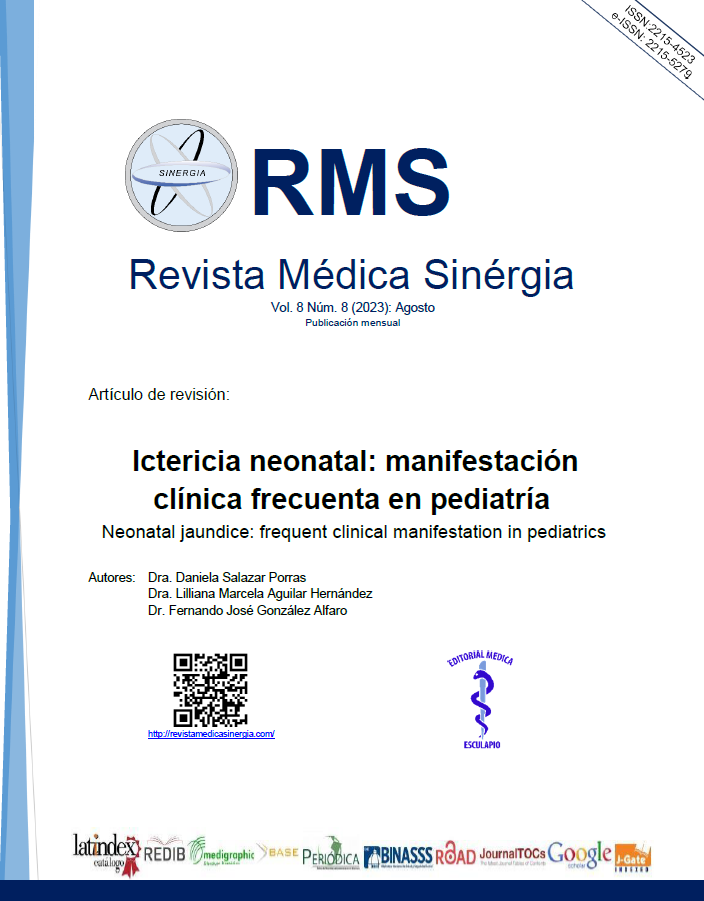Abstract
Neonatal jaundice consists of the appearance of yellowish discoloration in the skin and mucous membranes, particularly in the sclera, which occurs during the first days of a newborn's life and is considered one of the most frequent reasons for consultation in neonatal period.
This condition is due to excess bilirubin in the blood, which accumulates in the tissues when its serum levels exceed a certain threshold.
According to estimates, globally there are around 481,000 cases of hyperbilirubinemia and jaundice in newborns each year, of which approximately 63,000 survive but are left with severe chronic disability.
Various factors have been identified that increase the risk of developing jaundice in newborns, the most relevant being prematurity, breastfeeding, the male gender, a gestational age of less than 37 weeks, the presence of extravasated blood and the reabsorption of hematomas such as cephalohematoma, increased red cell mass in case of polycythemia, increased enterohepatic circulation, intrauterine infections, ABO or Rh incompatibility, untreated maternal urinary tract infections, and neonatal sepsis.
It is recommended to carefully examine the skin to detect the level and extent of yellowing, which indicates jaundice, whose levels may be greater than 5 mg/dL of bilirubin. It is also important to observe if the neonate presents plethora, macrosomia, or any hematoma on the head.
The diagnosis of neonatal jaundice caused by hyperbilirubinemia is commonly suspected by yellowing of the newborn but must be confirmed by measurement of serum bilirubin levels, although transcutaneous measurement is now also used. Phototherapy and exchange transfusion are used to treat it.
Keywords
References
Bhutani VK, Johnson L. Jaundice and hyperbilirubinemia in the newborn. In: Kliegman RM, St. Geme III JW, Blum NJ, Shah SS, Tasker RC, Wilson KM, eds. Nelson Textbook of Pediatrics. 21st ed. Elsevier; 2019:858-869.
Evans HM, Siew SM. Neonatal liver disease. J Paediatr Child Health [Internet]. 2020 [citado el 15 abril 2023];56(11):1760–8. Disponible en: http://dx.doi.org/10.1111/jpc.15064
Kumar J, Saini L. Neonatal jaundice: Correspondence. Indian J Pediatr [Internet]. 2019 [citado el 15 abril 2023];86(9):867–8. Disponible en: http://dx.doi.org/10.1007/s12098-019-02964-x
May Uitz S, Hernández Martínez N, Madera Poot G. Efectividad de la fototerapia con luz led para disminuir hiperbillirrubinemia neonatal en pacientes críticos. SaludyBienestarSoc [Internet]. 2022 [citado el 09 abril 2023];6(1):79-8. Disponible en: https://www.revista.enfermeria.uady.mx/ojs/index.php/Salud/article/view/115
Olusanya BO, Kaplan M, Hansen TWR. Neonatal hyperbilirubinaemia: a global perspective. Lancet Child Adolesc Health [Internet]. 2018 [citado el 09 abril 2023];2(8):610–20. Disponible en: http://dx.doi.org/10.1016/S2352-4642(18)30139-1
Durrani HM, Zaman Z, Raza IM, Jamali M, Saleem A, Ejaz SM. Neonatal haemolytic disease with co-existing Anti-D and Anti-C antibodies. J Pak Med Assoc [Internet]. 2022 [citado el 09 abril 2023];72(11):2320–2. Disponible en: http://dx.doi.org/10.47391/JPMA.4564
Anderson NB, Calkins KL. Neonatal indirect hyperbilirubinemia. Neoreviews [Internet]. 2020 [citado el 09 abril 2023];21(11):e749–60. Disponible en: http://dx.doi.org/10.1542/neo.21-11-e749
Dysart K. Hiperbilirrubinemia neonatal [Internet]. Manual MSD versión para profesionales. [citado el 09 abril 2023]. Disponible en: https://www.msdmanuals.com/es-cr/professional/pediatr%C3%ADa/trastornos-metab%C3%B3licos-electrol%C3%ADticos-y-t%C3%B3xicos-en-reci%C3%A9n-nacidos/hiperbilirrubinemia-neonatal
González-Valcárcel M, Raynero Mellado R, Caballero Martín S. Ictericia neonatal. Pediatría integral [Internet]. 2019 [citado el 09 abril 2023]. Disponible en: https://www.pediatriaintegral.es/publicacion-2019-05/ictericia-neonatal-2/
Orihuela R. Factores de riesgo en recién nacidos con ictericia neonatal en el servicio de Neonatología en los Andes centrales del Perú, 2019. Revista Científica de la Facultad de Medicina Humana - UPLA [Internet]. 2020. [citado el 09 abril 2023];8(1):39–42. Disponible en: http://dx.doi.org/10.51701/medicina.v8i1.97
Amegan-Aho KH, Segbefia CI, Glover NDO, Ansa GA, Afaa TJ. Ictericia neonatal: conciencia, percepción y prácticas preventivas en gestantes. Ghana Med J [Internet]. 2019 [citado el 09 abril 2023];53(4):267–72. Disponible en: http://dx.doi.org/10.4314/gmj.v53i4.3
Lee HY, Ithnin A, Azma RZ, Othman A, Salvador A, Cheah FC. Glucose-6-phosphate dehydrogenase deficiency and neonatal hyperbilirubinemia: Insights on pathophysiology, diagnosis, and gene variants in disease heterogeneity. Front Pediatr [Internet]. 2022 [citado el 09 abril 2023];10:875877. Disponible en: http://dx.doi.org/10.3389/fped.2022.87587
Alkén J, Håkansson S, Ekéus C, Gustafson P, Norman M. Rates of extreme neonatal hyperbilirubinemia and kernicterus in children and adherence to national guidelines for screening, diagnosis, and treatment in Sweden. JAMA Netw Open [Internet]. 2019 [citado el 09 abril 2023];2(3):e190858. Disponible en: http://dx.doi.org/10.1001/jamanetworkopen.2019.0858
Dysart K. Encefalopatía icterica (kernicterus) [Internet]. Manual MSD versión para profesionales. 2021 [citado el 09 abril 2023]. Disponible en: https://www.msdmanuals.com/es-cr/professional/pediatr%C3%ADa/trastornos-metabólicos-electrol%C3%ADticos-y-tóxicos-en-recién-nacidos/encefalopat%C3%ADa-ictérica-kern%C3%ADcterus
Montealegre A, Charpak N, Parra A, Devia C, Coca I, Bertolotto AM. Effectiveness and safety of two phototherapy devices for the humanized management of neonatal jaundice. Anales de Pediatría [Internet]. 2020 [citado el 09 abril 2023];92(2):79–87. Disponible en: http://dx.doi.org/10.1016/j.anpedi.2019.02.008
Wang J, Guo G, Li A, Cai W-Q, Wang X. Challenges of phototherapy for neonatal hyperbilirubinemia (Review). Exp Ther Med [Internet]. 2021 [citado el 09 abril 2023];21(3):231. Disponible en: http://dx.doi.org/10.3892/etm.2021.9662

This work is licensed under a Creative Commons Attribution-NonCommercial 4.0 International License.
Copyright (c) 2023 Array


